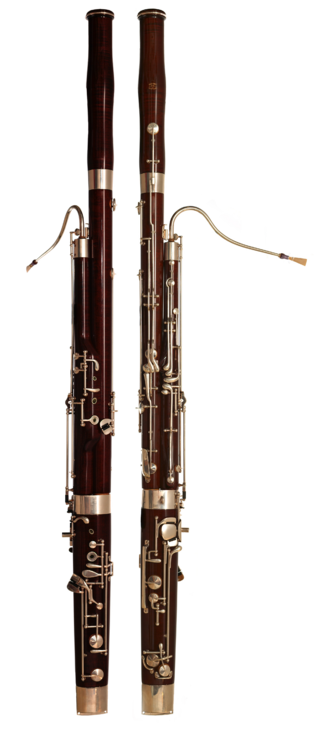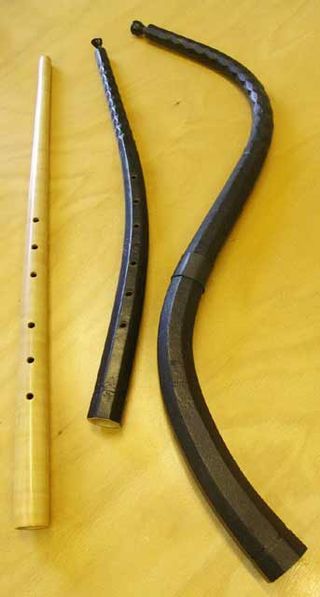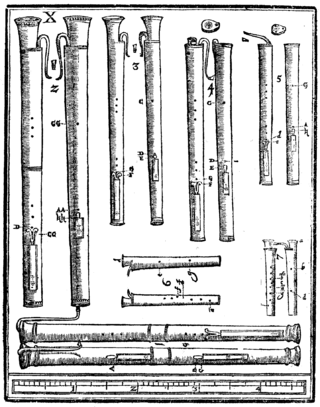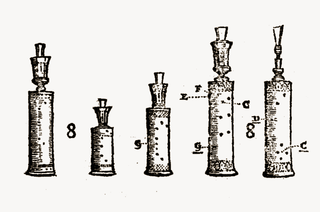
The bassoon is a woodwind instrument in the woodwind family, which plays in the tenor and bass ranges. It is composed of six pieces, and is usually made of wood. It is known for its distinctive tone color, wide range, versatility, and virtuosity. It is a non-transposing instrument and typically its music is written in the bass and tenor clefs, and sometimes in the treble. There are two forms of modern bassoon: the Buffet and Heckel systems. It is typically played while sitting using a seat strap, but can be played while standing if the player has a harness to hold the instrument. Sound is produced by rolling both lips over the reed and blowing direct air pressure to cause the reed to vibrate. Its fingering system can be quite complex when compared to those of other instruments. Appearing in its modern form in the 19th century, the bassoon figures prominently in orchestral, concert band, and chamber music literature, and is occasionally heard in pop, rock, and jazz settings as well. One who plays a bassoon is called a bassoonist.

The recorder is a family of woodwind musical instruments in the group known as internal duct flutes: flutes with a whistle mouthpiece, also known as fipple flutes. A recorder can be distinguished from other duct flutes by the presence of a thumb-hole for the upper hand and seven finger-holes: three for the upper hand and four for the lower. It is the most prominent duct flute in the western classical tradition.

A sackbut is an early form of the trombone used during the Renaissance and Baroque eras. A sackbut has the characteristic telescopic slide of a trombone, used to vary the length of the tube to change pitch, but is distinct from later trombones by its smaller, more cylindrically-proportioned bore, and its less-flared bell. Unlike the earlier slide trumpet from which it evolved, the sackbut possesses a U-shaped slide with two parallel sliding tubes, rather than just one.

The cornett, cornetto, or zink is an early wind instrument that dates from the Medieval, Renaissance and Baroque periods, popular from 1500 to 1650.

The crumhorn is a double reed instrument of the woodwind family, most commonly used during the Renaissance period. In modern times, particularly since the 1960s, there has been a revival of interest in early music, and crumhorns are being played again. It was also spelled krummhorn, krumhorn, krum horn, and cremorne.

The shawm is a conical bore, double-reed woodwind instrument made in Europe from the 12th century to the present day. It achieved its peak of popularity during the medieval and Renaissance periods, after which it was gradually eclipsed by the oboe family of descendant instruments in classical music. It is likely to have come to Western Europe from the Eastern Mediterranean around the time of the Crusades. Double-reed instruments similar to the shawm were long present in Southern Europe and the East, for instance the ancient Greek, and later Byzantine, aulos, the Persian sorna, and the Armenian duduk.

The tenor saxophone is a medium-sized member of the saxophone family, a group of instruments invented by Adolphe Sax in the 1840s. The tenor and the alto are the two most commonly used saxophones. The tenor is pitched in the key of B♭ (while the alto is pitched in the key of E♭), and written as a transposing instrument in the treble clef, sounding an octave and a major second lower than the written pitch. Modern tenor saxophones which have a high F♯ key have a range from A♭2 to E5 (concert) and are therefore pitched one octave below the soprano saxophone. People who play the tenor saxophone are known as "tenor saxophonists", "tenor sax players", or "saxophonists".

The dulcian is a Renaissance woodwind instrument, with a double reed and a folded conical bore. Equivalent terms include English: curtal, German: Dulzian, French: douçaine, Dutch: dulciaan, Italian: dulciana, Spanish: bajón, and Portuguese: baixão.

The rackett, raggett, cervelas, or sausage bassoon is a Renaissance-era double reed wind instrument, introduced late in the sixteenth century and already superseded by bassoons at the end of the seventeenth century.

A rauschpfeife is a capped conical reed musical instrument of the woodwind family, used in Europe in the 16th and 17th centuries. In common with the crumhorn and cornamuse, it is a wooden double-reed instrument with the reed enclosed in a windcap. The player blows into a slot in the top of the windcap to produce the sound.

The kortholt is a musical instrument of the woodwind family, used in the Renaissance period.

The cornamuse is a double reed instrument dating from the Renaissance period. It is similar to the crumhorn in having a windcap over the reed and cylindrical bore. The only evidence for the cornamuse comes from a description and a few comments by Michael Praetorius in Syntagma musicum II, published in 1619. Since the paragraph by Praetorius is the only clear description of the cornamuse and no period specimen or picture has been found, all reconstructions of the instrument rely on a certain amount of conjecture.

During the reign of Queen Elizabeth I (1558–1603), English art and high culture reached a pinnacle known as the height of the English Renaissance. Elizabethan music experienced a shift in popularity from sacred to secular music and the rise of instrumental music. Professional musicians were employed by the Church of England, the nobility, and the rising middle-class.

The tenor cornett or lizard was a common musical instrument in the Renaissance and Baroque periods. This instrument was normally built in C and the pedal (lowest) note of the majority of tenor cornetts was the C below middle C. A number of surviving instruments feature a key to secure the lowest note. The instrument has a useful range of approximately two and a half octaves, however, an experienced player with a strong embouchure may be able to push the instrument higher.

Variants of the bock, a type of bagpipe, were played in Central Europe in what are the modern states of Austria, Germany, Poland and the Czech Republic. The tradition of playing the instrument endured into the 20th century, primarily in the Blata, Chodsko, and Egerland regions of Bohemia, and among the Sorbs of Saxony. The name "Bock" refers to the use of goatskins in constructing the bag, similar to the common use of other goat-terms for bagpipes in other nations, such as the French cabrette.
Reed aerophones is one of the categories of musical instruments found in the Hornbostel-Sachs system of musical instrument classification. In order to produce sound with these Aerophones the player's breath is directed against a lamella or pair of lamellae which periodically interrupt the airflow and cause the air to be set in motion.
The sopranino recorder is the second smallest recorder of the modern recorder family, and was the smallest before the 17th century.
The garklein recorder in C, also known as the sopranissimo recorder or piccolo recorder, is the smallest size of the recorder family. Its range is C6–A7 (C8). The name garklein is German for "quite small", and is also sometimes used to describe the sopranino in G. Although some modern German makers use the single-word form Garkleinflötlein, this is without historical precedent. Double holes for the two lowest notes (used on the larger recorders to achieve a fully chromatic scale) are uncommon. The instrument is usually notated in the treble clef two octaves lower than its actual sound. The garklein recorder is only about 16 to 18 cm long and is different from larger recorders in that it is usually made in one piece due to its size.

A bass recorder is a wind instrument in F3 that belongs to the family of recorders.















